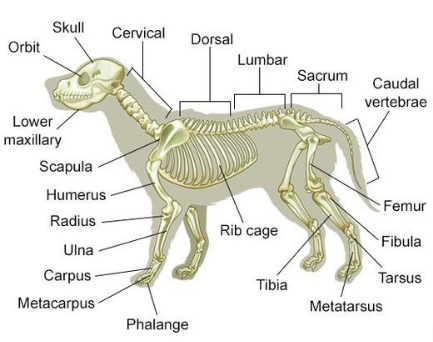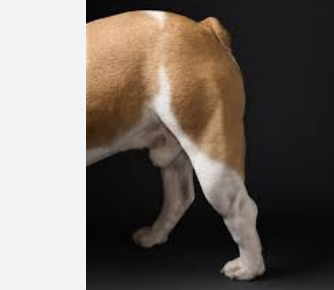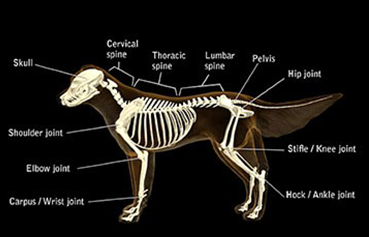There are 321 bones in a dog’s body on average, though this obviously varies from breed to breed. Generally speaking, longer tails have more vertebrae than their shorter counterparts, which accounts for the majority of the bone variation between breeds.
Let’s delve more deeply into some of the additional nuances of dogs and their bones.
Dogs and Bones
Every living thing’s basic structure is made up of bones. Animals’ shape, size, stability, and classification are determined by the design and construction of their bones, which are the hardest part of their bodies. A complex skeletal system forms a dog’s body, each bone playing a vital role in the dog’s health and nutrition.
Bones are made of minerals, including calcium, magnesium, and phosphorus, and protein-containing essential amino acids, including lysine.
Like any other living thing, this combination of minerals and proteins gives strength to the bones and stability to the dog’s body.
Table of Contents
- How Many Bones Does a Dog Have?
- How Long Does It Take to Develop the Skeletal Structure of Dogs Fully?
- Decoding the Skeletal Structure of Dogs
- Dog Bones Vs Human Bones
- What Are the Common Bone Disorders of Dogs?
- How Long Does It Take for a Dog’s Broken Bone to Heal?
- Preventing Bone Injuries
- Final Thoughts: Dog Has 321 Bones
- FAQs
How Many Bones Does a Dog Have?
An animal’s structure is built up of bones. Dogs’ skeletons also contain sesamoid, sesamoid-like, sesamoid, flat, and irregular bone types.
Dogs may have a slight variation in the number of bones depending on the breed of the dog, but generally, there are 321 bones in a dog’s skeletal system, differentiated as the following.
| Skeletal System | Number of Bones |
| Vertebral column | 50 |
| Skull and hyoid bones | 50 |
| Ribs and sternum | 34 |
| The thoracic limb | 90 |
| The pelvic limb | 96 |
| Heterotopic skeleton (baculum) | 1 |
Vertebral Column
The vertebral column has approximately 50 irregular bones that are again subdivided into 5 groups.
| Subdivision of Vertebral Column | Number of Bones |
| Cervical vertebrae | 7 |
| Thoracic vertebrae | 13 |
| Lumbar vertebrae | 7 |
| Sacral or sacrum | 3 |
| Caudal vertebrae | 19,20 |
Skull and Hyoid
A dog’s skull and hyoid bones vary from 36 to 50 bones according to the breed of the dog. The dog uses this bone to develop its facial structure. The bones are divided into 2 catalogs: cranium bones and facial bones.
Cranium Bones of a Dog’s Skull Contain
- Occipital, supraoccipital, and basioccipital bones,
- Parietal and interparietal bones,
- Frontal bone,
- The sphenoid bone. (presphenoid and basisphenoid),
- A temporal bone,
- The ethmoid bone.
The Facial Bones of a Dog’s Skull Contain
- Incisive bones,
- The nasal bone,
- Maxilla bone,
- Zygomatic and palatine bones,
- Lacrimal, pterygoid, and vomer bones,
- Dorsal and ventral concha,
- Mandible.
Thoracic Limb
The thoracic limb of dogs contains 90 bones responsible for the dog’s movement. Each of their two thoracic limbs contains 45 bones. They are:
- The bones that form the shoulder girdles are the scapula, clavicle, and coracoid.
- The dog’s humerus is its arm bone, also known as its brachium bone.
- Radial and ulna bones are found in the forearm or antebrachium.
- The Carpal, metacarpal, and phalanges are bones of the manus
- Proximal and distal sesamoid bones can be found in the thoracic limb.
Pelvic Limbs
Similar to the thoracic limbs, pelvic limbs come in a pair of 48 bones each, serving a dog in its movement. These limbs consist of:
- The ilium, ischium, and pubis are among the Os coxae bones.
- The canine femur is located in the thigh.
- The pelvic limb of a dog’s leg is made up of the tibial and fibula bones.
- The patella of the stifle joint contains a big sesamoid bone.
- The bones of the hind paw are covered by the tarsal, metatarsal, and phalanges.
- Both the proximal and distal sesamoid bones are found in the pelvic limb.
This all bone with cartilage, tissues, and ligaments to make the complete skeletal system of a dog.
How Long Does It Take to Develop the Skeletal Structure of Dogs Fully?
Depending on the breed, most dogs take about 12 to 18 months to have fully developed skeletal structures.
The time for a dog to reach maturity depends on the size and breed of the dog. For a large dog to fully mature, it takes 15 to 18 months of growth, whereas, for small dogs, it only takes a few months.
For instance, the small Pomeranians reach their full skeletal structure in 6 to 10 months and grow up to be 7 to 12 inches tall and 3 to 7 pounds in weight.
Rottweilers, on the other hand, are between 24 and 27 inches tall and weigh 90 to 120 pounds. It takes them roughly 18 to 20 months to reach full adult size.
Decoding the Skeletal Structure of Dogs
The deviation in the skeleton composition and size of the dog is more critical than any other animal. The dog’s skeleton arrangement has three parts: the visceral, the appendicular, and the axial.
The axial part is the major part that holds the crucial parts of the system, which are the sternum, spine, ribs, head, and neck.
The small bone structures are included in the visceral part: the inner ear and the appendicular skeleton, including the feet and leg skeleton.
The dogs have disconnected shoulder bones, and in place of the collarbone, they have cartilage which is called a rudimentary collarbone. This feature of the absence of a collarbone helps them in running motion; their flexibility is increased and gives them extraordinary stride lengths.
There is division in the structure of the skeleton, there are long, short, flat, sesamoid, and irregular bones.
The dogs’ weight, motion, and flexibility are supported by the limbs, which are included in the long bones. The short bones are the wrists and ankles that provide movement and stability to the dog.
Ribs, shoulders, pelvis, and sternum are the flat bones that help connect long bones and muscles. The flat bones are also present in the skull and give protection to the sinuses, eyes, brain, and ears.
The knees and wrists have freely moving bones that contain the Sesamoid bones. The skull, vertebral column, and hipbone have irregular bones in some parts.

Dog Bones Vs Human Bones
Start by contrasting dog bones with human bones; this comparison might be useful. The bones in dog skeletons and those of humans differ in a number of intriguing ways, in addition to the fact that we lack tails.
One difference between humans and dogs is that humans have significantly fewer bones. In comparison to humans, dogs have 321 bones in their bodies. The majority of scientists believe that teeth and vertebrae are responsible for the dog’s extra bones. However, the majority of the bones in humans are found in the hands and feet. Human hands and feet alone contain 106 bones, or 27 bones per hand and 26 bones per foot.
Dogs have more bones than humans do, and they’re also stronger, less porous, and denser.
What Are the Common Bone Disorders of Dogs?
Dogs, like all other animals, are prone to a few health issues, many of which are joint issues. Some common bone disorders include:
Panosteitis
This disorder is also called “long bone pain” or “growing pain.” In this disorder, information occurs on the surface of the long bones. This could affect several bones at once or cause the lameness to shift from one bone to another.
This disorder is self-limiting but can occur at regular intervals. Several medications can treat the pain that panosteitis causes in the body.
Osteochondrosis

Osteochondrosis is a threatening disorder where the cartilage joining the bones loses its strength and weakens the joint. In the extreme case, the cartilage is completely detached from the joint.
This can be cured only by maintaining a proper diet for the dog without calcium. Always seek advice from a veterinarian when in doubt.
Hypertrophic Osteodystrophy
In this disorder, there is inflammation in the growth plates of the long bones, causing pain and swelling in the joints and ending up in fever and loss of appetite.
It is self-limiting without any permanent damage, but the growth plates permanently deform the dogs’ legs in some cases. Care and treatment with medication can decrease the pain and control the information of the growth plates.
Hip Dysplasia
Ball and socket joints are found in the hips. During the growing stage, both the ball and the socket should expand equally. The dog suffers from a hip dysplasia diagnosis if they don’t grow at a similar rate.
Lameness in your dog and trouble getting out of lying to a standing position are signs of this disorder. This can be treated with certain medications and preventative care, while severe cases have to undergo surgery.
Osteochondrosis Dissecans
OCD and OD are other names for osteochondrosis dissecans. The smooth cartilage gets defective in one or many joints in the disorder. It mainly affects the shoulder joint, but the knee, elbow, and hip can also be affected.
It has different stages of pain mild, intermediate to intense. For several weeks, strict resting and a limited activity schedule are the only ways to treat some of these conditions. In severe circumstances, the joint’s cartilage can separate entirely.
Surgery and the removal of damaged parts are the treatments that are most frequently advised for OCD.
How Long Does It Take for a Dog’s Broken Bone to Heal?
Depending on the bone broken and how badly it was broken, your dog may need a certain amount of time to heal. These details can be ascertained by your veterinarian, who can also provide you with an estimation of the healing time for the broken bone in your dog. However, in general, healing from a broken bone will take at least 4 weeks in young puppies and at least 8 weeks in older dogs.
Preventing Bone Injuries
You can help promote your dog’s bone health by ensuring a top-quality, healthy diet, preventative care like orthopedic beds, and providing your dog with adequate exercise that will have the both of you in the pink of health!
Also, if you have slippery tiles or hardwood floors, you might want to make a few tweaks to your home to ensure that your dog isn’t constantly trying not to fall and potentially injure himself.
Additionally, puppy bones need to be safeguarded because they are prone to damage. A dog’s skeletal system takes roughly 6 to 18 months to fully develop; the larger the dog, the longer it takes.
With young puppies, avoid having them use the stairs excessively or jump up and down the furniture. The constant impact could hurt the growth of their vulnerable bones and cause problems down the road.
Final Thoughts: Dog Has 321 Bones
A dog has 321 bones in their bodies, each one playing a vital role in the dog’s function and form. Their skeletal system is divided into three crucial parts that are axial, visceral, and appendicular. Bone health is vital to the well-being and happiness of a dog.
Your beloved dog can live a long, healthy life with the right upkeep and care!
FAQs
How Many Bones Do Cats Have?
230
The skeleton of a cat and a human are similar in some ways. The cat has more bones—230 as opposed to 206—but many are identical to those in the human being. There are 12 ribs in humans and 13 in cats. Cats do have clavicles (collar bones), but they are not connected to other bones like they are in humans.
How Many Bones Does a Dog Have in Its Tail?
A dog’s tail contains how many bones, then? The number of tail bones (caudal vertebrae) varies greatly among dog breeds. The average tail bone count is 20, but different dog breeds can have anywhere between 6 and 24 bones.
The body, arch, and processes are located in the first one or two caudal vertebrae of a dog. However, the remaining caudal vertebrae have a cylindrical body and altered cranial and caudal articular processes.
How Many Bones Are in a Dogs Paw?
There are four larger bones of the hind and forelimb paws called the metatarsals and metacarpals, respectively. The metatarsal and metacarpal bones, also known as the digits or toes, are joined by a group of three smaller bones.
What Animal Has the Most Bones?
The longest snake in the world would have the most bones. The body of the Python is thought to contain about 600 vertebrae, or about 1800 bones in total.
